Johan Obando-Ceron
Asymmetric Proximal Policy Optimization: mini-critics boost LLM reasoning
Oct 02, 2025Abstract:Most recent RL for LLMs (RL4LLM) methods avoid explicit critics, replacing them with average advantage baselines. This shift is largely pragmatic: conventional value functions are computationally expensive to train at LLM scale and often fail under sparse rewards and long reasoning horizons. We revisit this bottleneck from an architectural perspective and introduce Asymmetric Proximal Policy Optimization (AsyPPO), a simple and scalable framework that restores the critics role while remaining efficient in large-model settings. AsyPPO employs a set of lightweight mini-critics, each trained on disjoint prompt shards. This design encourages diversity while preserving calibration, reducing value-estimation bias. Beyond robust estimation, AsyPPO leverages inter-critic uncertainty to refine the policy update: (i) masking advantages in states where critics agree and gradients add little learning signal, and (ii) filtering high-divergence states from entropy regularization, suppressing spurious exploration. After training on open-source data with only 5,000 samples, AsyPPO consistently improves learning stability and performance across multiple benchmarks over strong baselines, such as GRPO, achieving performance gains of more than six percent on Qwen3-4b-Base and about three percent on Qwen3-8b-Base and Qwen3-14b-Base over classic PPO, without additional tricks. These results highlight the importance of architectural innovations for scalable, efficient algorithms.
Recursive Self-Aggregation Unlocks Deep Thinking in Large Language Models
Sep 30, 2025Abstract:Test-time scaling methods improve the capabilities of large language models (LLMs) by increasing the amount of compute used during inference to make a prediction. Inference-time compute can be scaled in parallel by choosing among multiple independent solutions or sequentially through self-refinement. We propose Recursive Self-Aggregation (RSA), a test-time scaling method inspired by evolutionary methods that combines the benefits of both parallel and sequential scaling. Each step of RSA refines a population of candidate reasoning chains through aggregation of subsets to yield a population of improved solutions, which are then used as the candidate pool for the next iteration. RSA exploits the rich information embedded in the reasoning chains -- not just the final answers -- and enables bootstrapping from partially correct intermediate steps within different chains of thought. Empirically, RSA delivers substantial performance gains with increasing compute budgets across diverse tasks, model families and sizes. Notably, RSA enables Qwen3-4B-Instruct-2507 to achieve competitive performance with larger reasoning models, including DeepSeek-R1 and o3-mini (high), while outperforming purely parallel and sequential scaling strategies across AIME-25, HMMT-25, Reasoning Gym, LiveCodeBench-v6, and SuperGPQA. We further demonstrate that training the model to combine solutions via a novel aggregation-aware reinforcement learning approach yields significant performance gains. Code available at https://github.com/HyperPotatoNeo/RSA.
Stable Gradients for Stable Learning at Scale in Deep Reinforcement Learning
Jun 18, 2025

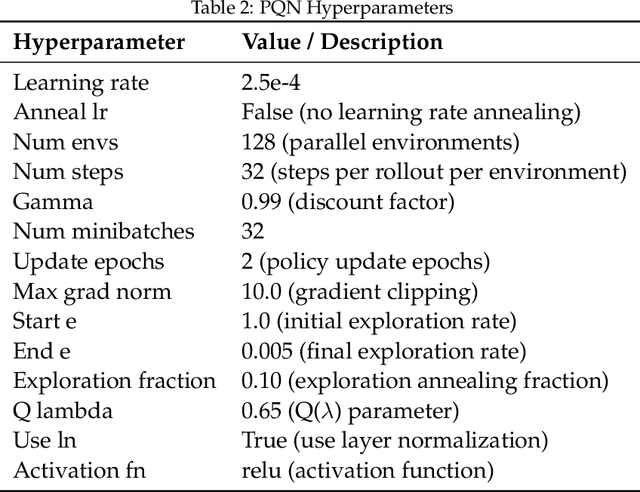

Abstract:Scaling deep reinforcement learning networks is challenging and often results in degraded performance, yet the root causes of this failure mode remain poorly understood. Several recent works have proposed mechanisms to address this, but they are often complex and fail to highlight the causes underlying this difficulty. In this work, we conduct a series of empirical analyses which suggest that the combination of non-stationarity with gradient pathologies, due to suboptimal architectural choices, underlie the challenges of scale. We propose a series of direct interventions that stabilize gradient flow, enabling robust performance across a range of network depths and widths. Our interventions are simple to implement and compatible with well-established algorithms, and result in an effective mechanism that enables strong performance even at large scales. We validate our findings on a variety of agents and suites of environments.
The Courage to Stop: Overcoming Sunk Cost Fallacy in Deep Reinforcement Learning
Jun 16, 2025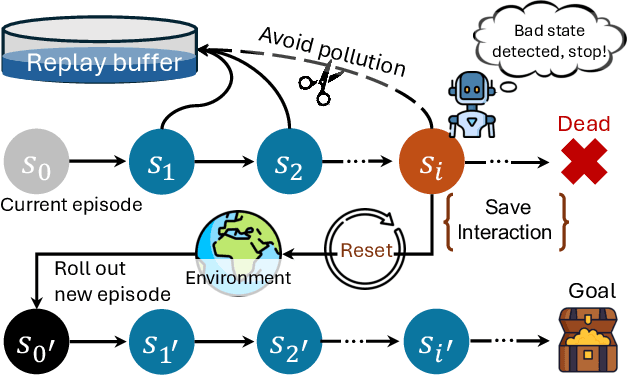
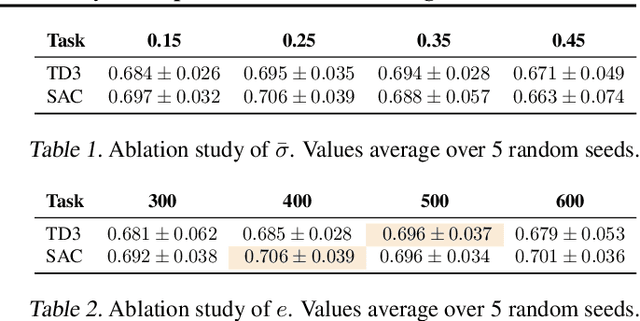
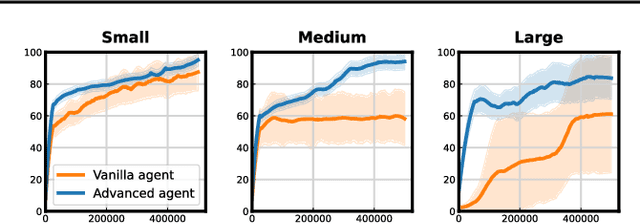
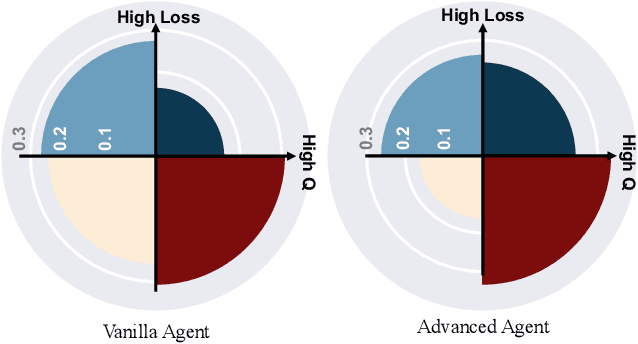
Abstract:Off-policy deep reinforcement learning (RL) typically leverages replay buffers for reusing past experiences during learning. This can help improve sample efficiency when the collected data is informative and aligned with the learning objectives; when that is not the case, it can have the effect of "polluting" the replay buffer with data which can exacerbate optimization challenges in addition to wasting environment interactions due to wasteful sampling. We argue that sampling these uninformative and wasteful transitions can be avoided by addressing the sunk cost fallacy, which, in the context of deep RL, is the tendency towards continuing an episode until termination. To address this, we propose learn to stop (LEAST), a lightweight mechanism that enables strategic early episode termination based on Q-value and gradient statistics, which helps agents recognize when to terminate unproductive episodes early. We demonstrate that our method improves learning efficiency on a variety of RL algorithms, evaluated on both the MuJoCo and DeepMind Control Suite benchmarks.
Measure gradients, not activations! Enhancing neuronal activity in deep reinforcement learning
May 29, 2025Abstract:Deep reinforcement learning (RL) agents frequently suffer from neuronal activity loss, which impairs their ability to adapt to new data and learn continually. A common method to quantify and address this issue is the tau-dormant neuron ratio, which uses activation statistics to measure the expressive ability of neurons. While effective for simple MLP-based agents, this approach loses statistical power in more complex architectures. To address this, we argue that in advanced RL agents, maintaining a neuron's learning capacity, its ability to adapt via gradient updates, is more critical than preserving its expressive ability. Based on this insight, we shift the statistical objective from activations to gradients, and introduce GraMa (Gradient Magnitude Neural Activity Metric), a lightweight, architecture-agnostic metric for quantifying neuron-level learning capacity. We show that GraMa effectively reveals persistent neuron inactivity across diverse architectures, including residual networks, diffusion models, and agents with varied activation functions. Moreover, resetting neurons guided by GraMa (ReGraMa) consistently improves learning performance across multiple deep RL algorithms and benchmarks, such as MuJoCo and the DeepMind Control Suite.
Kaleidoscope: In-language Exams for Massively Multilingual Vision Evaluation
Apr 09, 2025Abstract:The evaluation of vision-language models (VLMs) has mainly relied on English-language benchmarks, leaving significant gaps in both multilingual and multicultural coverage. While multilingual benchmarks have expanded, both in size and languages, many rely on translations of English datasets, failing to capture cultural nuances. In this work, we propose Kaleidoscope, as the most comprehensive exam benchmark to date for the multilingual evaluation of vision-language models. Kaleidoscope is a large-scale, in-language multimodal benchmark designed to evaluate VLMs across diverse languages and visual inputs. Kaleidoscope covers 18 languages and 14 different subjects, amounting to a total of 20,911 multiple-choice questions. Built through an open science collaboration with a diverse group of researchers worldwide, Kaleidoscope ensures linguistic and cultural authenticity. We evaluate top-performing multilingual vision-language models and find that they perform poorly on low-resource languages and in complex multimodal scenarios. Our results highlight the need for progress on culturally inclusive multimodal evaluation frameworks.
Adaptive Computation Pruning for the Forgetting Transformer
Apr 09, 2025Abstract:The recently proposed Forgetting Transformer (FoX) incorporates a forget gate into softmax attention and has shown consistently better or on-par performance compared to the standard RoPE-based Transformer. Notably, many attention heads in FoX tend to forget quickly, causing their output at each timestep to rely primarily on the local context. Based on this observation, we propose Adaptive Computation Pruning (ACP) for FoX, a method that dynamically prunes computations involving input-output dependencies that are strongly decayed by the forget gate. This is achieved using a dynamically set pruning threshold that ensures that the pruned attention weights remain negligible. We apply ACP to language model pretraining with FoX and show it consistently reduces the number of FLOPs in softmax attention by around 70% across different model sizes and context lengths, resulting in a roughly 10% to 35% improvement in training throughput. Furthermore, longer context lengths yield greater computational savings. All these speed improvements are achieved without any performance degradation. We also perform several analyses to provide deeper insights into our method, such as examining the pruning patterns and analyzing the distribution of FLOP savings across different attention heads. Our code is available at https://github.com/zhixuan-lin/arctic-fox.
Trajectory Balance with Asynchrony: Decoupling Exploration and Learning for Fast, Scalable LLM Post-Training
Mar 24, 2025Abstract:Reinforcement learning (RL) is a critical component of large language model (LLM) post-training. However, existing on-policy algorithms used for post-training are inherently incompatible with the use of experience replay buffers, which can be populated scalably by distributed off-policy actors to enhance exploration as compute increases. We propose efficiently obtaining this benefit of replay buffers via Trajectory Balance with Asynchrony (TBA), a massively scalable LLM RL system. In contrast to existing approaches, TBA uses a larger fraction of compute on search, constantly generating off-policy data for a central replay buffer. A training node simultaneously samples data from this buffer based on reward or recency to update the policy using Trajectory Balance (TB), a diversity-seeking RL objective introduced for GFlowNets. TBA offers three key advantages: (1) decoupled training and search, speeding up training wall-clock time by 4x or more; (2) improved diversity through large-scale off-policy sampling; and (3) scalable search for sparse reward settings. On mathematical reasoning, preference-tuning, and automated red-teaming (diverse and representative post-training tasks), TBA produces speed and performance improvements over strong baselines.
All Languages Matter: Evaluating LMMs on Culturally Diverse 100 Languages
Nov 25, 2024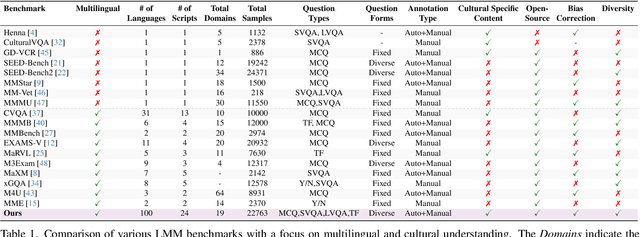
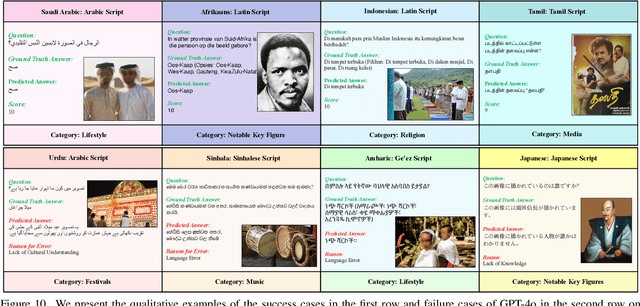
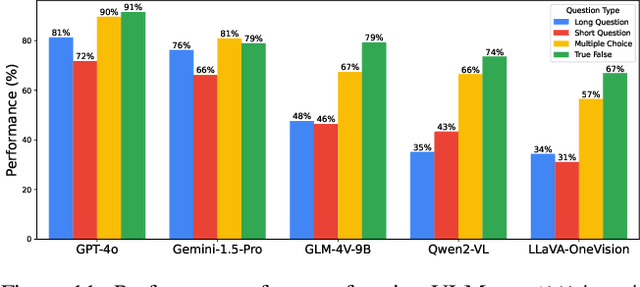

Abstract:Existing Large Multimodal Models (LMMs) generally focus on only a few regions and languages. As LMMs continue to improve, it is increasingly important to ensure they understand cultural contexts, respect local sensitivities, and support low-resource languages, all while effectively integrating corresponding visual cues. In pursuit of culturally diverse global multimodal models, our proposed All Languages Matter Benchmark (ALM-bench) represents the largest and most comprehensive effort to date for evaluating LMMs across 100 languages. ALM-bench challenges existing models by testing their ability to understand and reason about culturally diverse images paired with text in various languages, including many low-resource languages traditionally underrepresented in LMM research. The benchmark offers a robust and nuanced evaluation framework featuring various question formats, including true/false, multiple choice, and open-ended questions, which are further divided into short and long-answer categories. ALM-bench design ensures a comprehensive assessment of a model's ability to handle varied levels of difficulty in visual and linguistic reasoning. To capture the rich tapestry of global cultures, ALM-bench carefully curates content from 13 distinct cultural aspects, ranging from traditions and rituals to famous personalities and celebrations. Through this, ALM-bench not only provides a rigorous testing ground for state-of-the-art open and closed-source LMMs but also highlights the importance of cultural and linguistic inclusivity, encouraging the development of models that can serve diverse global populations effectively. Our benchmark is publicly available.
Neuroplastic Expansion in Deep Reinforcement Learning
Oct 10, 2024



Abstract:The loss of plasticity in learning agents, analogous to the solidification of neural pathways in biological brains, significantly impedes learning and adaptation in reinforcement learning due to its non-stationary nature. To address this fundamental challenge, we propose a novel approach, Neuroplastic Expansion (NE), inspired by cortical expansion in cognitive science. NE maintains learnability and adaptability throughout the entire training process by dynamically growing the network from a smaller initial size to its full dimension. Our method is designed with three key components: (1) elastic neuron generation based on potential gradients, (2) dormant neuron pruning to optimize network expressivity, and (3) neuron consolidation via experience review to strike a balance in the plasticity-stability dilemma. Extensive experiments demonstrate that NE effectively mitigates plasticity loss and outperforms state-of-the-art methods across various tasks in MuJoCo and DeepMind Control Suite environments. NE enables more adaptive learning in complex, dynamic environments, which represents a crucial step towards transitioning deep reinforcement learning from static, one-time training paradigms to more flexible, continually adapting models.
 Add to Chrome
Add to Chrome Add to Firefox
Add to Firefox Add to Edge
Add to Edge